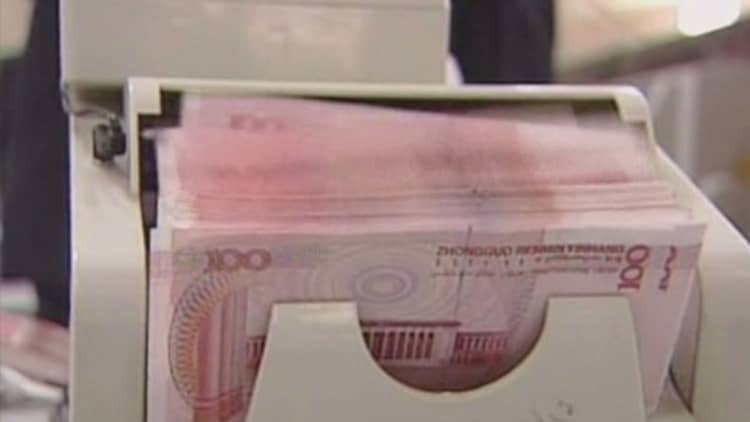
Goldman Sachs has shifted to an "outright negative" view on the yuan, blaming the change in sentiment on a "weak link" in the mainland's currency management strategy.
The bank's analysts said although Beijing had moved changed its focus to the yuan's against a basket of currencies, Chinese consumers and businesses had not shifted their mindset away from the currency's dollar exchange rate.
That created a risk that the central bank's daily fix of the yuan against the greenback - which has gradually weakened - could spark panic, despite Chinese authorities' attempts to de-emphasize its importance, Goldman warned.
"The government has clearly communicated a shift in focus to a trade-weighted currency basket, de-emphasizing the signal that the bilateral exchange rate versus the dollar carries," the bank said in a Friday note. "But domestically, the only signal that matters is the dollar-yuan."
The People's Bank of China's (PBOC) daily dollar-yuan fixes have recently been at level that suggested a desire for a weaker yuan. The is allowed to move 2 percent in either direction from the fix level during daily trade.
On Friday, the PBOC set the dollar-yuan fix at 6.5793, down slightly from the five-year high of 6.5889 set on June 1, up from a recent low of 6.4565 in early May.
Goldman Sachs said the PBOC's signals for a weaker yuan could spur another damaging wave of fund outflows.
"Higher fixings could easily reignite capital flight, as households and firms anticipate a faster pace of depreciation," Goldman said. "Capital outflows are heavily expectation-based, such that weaker fixings inevitably fan anxiety that a bigger devaluation is in train."
A rush of funds for the exit would likely in turn put further pressure on the currency, Goldman added.
China suffered almost $700 billion worth of capital flight in 2015, according to the Institute of International Finance. Beijing logged $100 billion per month in average currency outflow during November, December and January but the pace of outflows had tapered off in more recent months, with net foreign exchange sales by commercial banks at $23.7 billion in April, from $36.4 billion in March, Reuters reported.
The surge in outflows late in 2015 sparked market concerns that China's foreign reserves weren't sufficient to stabilize the currency by buying yuan over the long term. In April, those reserves rose to $3.22 trillion, but that's off a peak of $3.99 trillion in June 2014, according to Reuters.
Goldman said a U.S interest rate rise was another factor that could spur fund outflows, because a hike would likely strengthen the dollar. The Federal Reserve is widely expected to increase interest rates in June or July, a possibility to which Goldman assigned a 70 percent probability.
While Goldman said it believed China's reserves were "more than sufficient" to deal with outflows, it added that it expected markets would again start speculating about a one-off yuan devaluation. In August, the PBOC unexpectedly sliced 2 percent off the value of the currency when it shifted to using the previous day's spot trade close to set the fix.
Goldman also cited the possibility of a serious knock-on risk if persistent fund outflows and a weaker renminbi came to fruition: It could derail the Fed's hiking cycle.
"One regularity over the past year has been that the S&P 500 has fallen sharply within a week or two of dollar-yuan fixing meaningfully higher, as focus on capital outflows and renminbi depreciation has built," it said. That could prevent the Fed from moving too quickly, the bank added.
—Nyshka Chandran contributed to this article.
Follow CNBC International on Twitter and Facebook.
—By CNBC.Com's Leslie Shaffer; Follow her on Twitter @LeslieShaffer1




